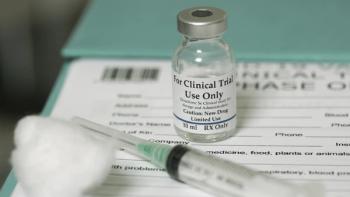
FDA holds CL microbiology workshop
The Food and Drug Administration (FDA) held a contact lens microbiology workshop in early September as a follow-up to its May meeting to discuss updating recommendations for contact lens and lens care guidance documents. The goal is safer contact lens wear for patients.
The Food and Drug Administration (FDA) held a
Keratitis outbreaks, Fusarium in 2006 and Acanthamoeba (AK) in 2007, have prompted researchers and industry to more closely examine the safety of contact lens wear, including the role of contact lens care solutions.
The workshop brought together representatives from the ophthalmic community to discuss how to revamp microbiology testing for better safety with
• FDA
• American Academy of Ophthalmology (AAOphth)
• American Academy of Optometry (AAOptom)
• American Optometric Association (AOA)
• Contact Lens Association of Ophthalmologists (CLAO)
AAOptom representative Loretta Szczotka-Flynn, OD, PhD, commented that panelists recommended changes that were reasonable, rational, achievable, and reproducible. “The speakers didn’t completely change the current recommendations, which some were afraid might happen,” she said. “They were enhanced. These changes are achievable by manufacturers, who are making these solutions that are both gentle to the eye and effective against these organisms. Nothing came out of here that was shocking.”
Said Joseph T. Barr, OD, MS, FAAO, “This was pleasingly candid. This group of experts spoke freely. The best thing that would happen would be if the FDA really is open to their recommendations. It’s going in a good direction for doctors to have confidence that contact lenses are a safe modality and can build their practices.” Dr. Barr is emeritus professor at The Ohio State University College of Optometry.
Panelist discussion
Much discussion focused on current testing methods for lens care products.
“We need to remember that disinfection does not eliminate all microorganisms,” said Ralph P. Stone, PhD, former vice president of consumer products research and development at Alcon, who presented at the meeting.
Three panels addressed specific topics.
Emerging pathogens in keratitis
Panel 1 looked at emerging pathogens in
Also noted by Elmer Tu, MD, director of the cornea and external disease section of the department of ophthalmology and visual sciences, University of Illinois College of Medicine, contact lenses are responsible for more than 50 percent of microbial keratitis (MK) cases, regardless of pathogen type, and there have been no significant improvements in the rates of MK over the past two decades.
Panel 1 determined that the current list of pathogens for testing is adequate, with the addition of Acanthamoeba, to determine disinfection efficacy for lens care products.
“Acanthamoeba needs to be added, and all strains should be updated to those that come from corneal infections, preferably from contact lens wear, and as recently as possible,” said Suzi Fleiszig, OD, PhD, panelist and professor of optometry at the University of California, Berkeley. It is important that any new strains come from a validated culture collection.
Soil and efficacy testing
Panel 2 looked at the role of soil in disinfection efficacy testing. It determined that defining testing process steps for consistency would be helpful, and the soil used should model the tear film for better assentation of efficacy and better replication of “real-world” scenarios could be considered. Note that “soil” used in solution efficacy testing is not soil in the true definition of the term but rather a composition of bovine serum and heated deactivated yeast cells used as an artificial contaminant for testing, providing both a broad spectrum of ingredients as well as cellular debris as may be present on worn lenses. The “soil” used for disinfection efficacy may not be appropriate for testing cleaning efficacy.
Acanthamoeba
Panel 3 looked at
AK is the most difficult disease to diagnose and manage successfully, said Simon Kilvington, PhD, senior lecturer in the department of infection, immunity and inflammation at the University of Leicester, UK. The recent outbreaks could not have been predicted from current ISO standards, he said.
“The incidence [of AK] in the U.S. has not returned to baseline seven years after the outbreak and recall of the implicated contact lens care solution,” he said.
Dr. Kilvington also commented that the method of Acanthamoeba cyst production significantly affects the efficacy of the test solution. “If you want to kill cysts, you need a two-step peroxide solution,” he said.
The panel addressed questions regarding the strains of Acanthamoeba currently used for testing. Dr. Tu commented that a 40-year-old strain may not reflect the current virulence. Selection of a strain or strains is important in developing methods for evaluation.
Panelists also commented on specific protocols for disinfection efficacy testing and starting such testing with an actual contact lens.
Said Dr. Tu: “The overarching theme here is that multipurpose solutions were very good and well accepted. But things change. We’re faced with a different risk now than we were even 10 years ago. There’s a difference in designing contact lens disinfection systems for those who live in New York vs. the Amazon in Brazil. If there’s a change in environment, it’s not the fault of the solution. It needs to be better, and we need to decide how to do that.”
Said Dr. Stone: “Do as much as you can do for the patient and doctor on high-risk behavior, such as swimming and water sports. We need to deal with those first high-risk behaviors, even if we’re not able to do much about the products. We’re a long way from the products being able to do a lot.”
Said Malvina Eydelman, MD: “We are well
Dr. Stone said that an international standard for Acanthamoeba encysting testing on lens care products should appear within the next year.
Denise Hampton, PhD, branch chief of the contact lenses and retinal devices branch of the FDA, commented that FDA’s research shows that the lens material makes a difference in contact lens uptake of biocide from lens solutions.
Mary Mowry-McKee, PhD, former research scientist at CIBAVision and Bausch + Lomb, said that such uptake does affect efficacy; a new ISO standard for evaluating lenses and case with the solution has been approved and will be issued by year’s end.
Additional discussion focused on the use of tap water with GP lenses. Said Dr. Szczotka-Flynn, OD, PhD, “I agree you can’t change behavior that easily. But you have to give patients tools to change their behavior. The majority of patients say, ‘I’ve been using tap water for 30 years, why should I change now?’ But then they ask, ‘What should I use instead?’ Why don’t we have larger bottles of aerosol saline?”
Other comments focused on obtaining evidence that tap water is a risk factor for GP lens wear and exploring options for other products.
Regarding developing new products for GP lenses, Jim Cook, head of corneal product development at Abbott Medical Optics, said, “We’re not a charitable organization. There needs to be a good market for it. If the contact lens organizations develop that market, then we could develop those products.”
As William Benjamin, OD, pointed out, tap water is easily available and costs nothing.
Newsletter
Want more insights like this? Subscribe to Optometry Times and get clinical pearls and practice tips delivered straight to your inbox.













































.png)


